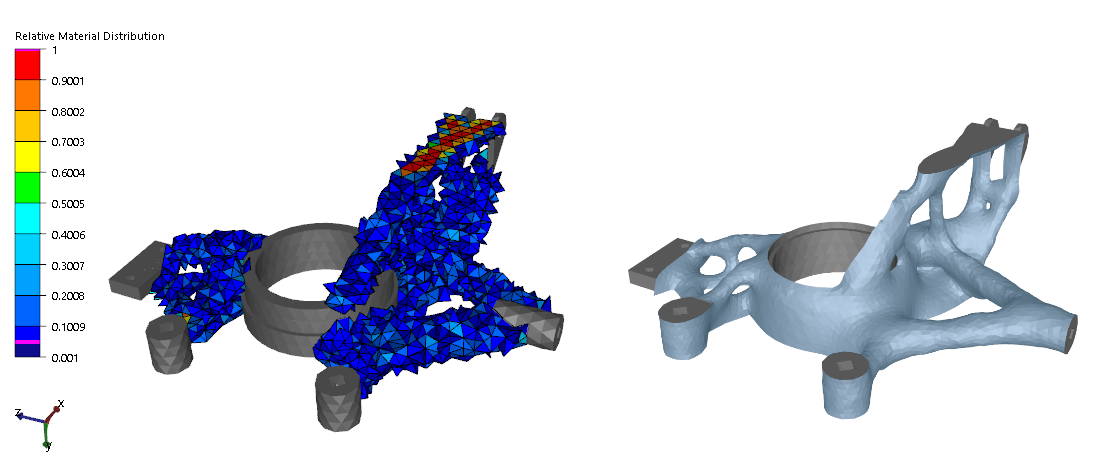-
Define input data and Design Variables:
FEM_INPUT
ID_NAME = INPUT_FILE
FILE = upright_mimp.inp
END_
DV_TOPO
ID_NAME = globalDesignArea
EL_GROUP = "Design_Space1"
END_
-
Define additional groups by combining (LIST_GROUP) and subtracting (LIST_SUBTRACT_GROUP) existing groups:
GROUP_DEF
ID_NAME = globalFrozenRegion
TYPE = ELEM
FORMAT = LIST_GROUP
LIST_BEGIN
"Functional Region1",
"Functional Region2",
"Functional Region3",
"Functional Region4",
"Functional Region5",
"Functional Region7",
"Functional Region8"
END_
GROUP_DEF
ID_NAME = designAreaNonFrozen
TYPE = ELEM
FORMAT = LIST_SUBTRACT_GROUP
LIST_BEGIN
"Design_Space1", globalFrozenRegion
END_
-
To use mass in the objective, define a Design Response (DRESP) as follows:
DRESP
ID_NAME = TASK_MASS
DEF_TYPE = SYSTEM
TYPE = WEIGHT
EL_GROUP = "Design_Space1"
GROUP_OPER = SUM
END_
-
Define the Objective Function (OBJ_FUNC) as follows:
OBJ_FUNC
ID_NAME = MY_OBJECTIVE
DRESP = TASK_MASS
TARGET = MIN
END_
-
To define the stress, displacement and frequency constraints, do the following:
-
Define the corresponding design responses (Here, one DRESP each for stress and displacement is shown instead of the total 4):
DRESP
ID_NAME = StressConstraint1_LC1
DEF_TYPE = SYSTEM
TYPE = SIG_TOPO_MISES
EL_GROUP = designAreaNonFrozen
LC_SET = ALL,1,ALL
END_
DRESP
ID_NAME = DisplacementConstraint1_LC1
DEF_TYPE = SYSTEM
TYPE = DISP_ABS
ND_GROUP = "Displacement Constraint6"
LC_SET = ALL,1,ALL
END_
DRESP
ID_NAME = eig1
DEF_TYPE = SYSTEM
TYPE = DYN_FREQ
UPDATE = EVER
LC_SET = MODAL,3,1
END_
-
Define the respective stress, displacement and frequency constraints (CONSTRAINT)
(Here, one CONSTRAINT each for stress and displacement is shown instead of the total 4):
CONSTRAINT
ID_NAME = CONSTRAINT_StressConstraint1_LC1
DRESP = StressConstraint1_LC1
MAGNITUDE = ABS
LE_VALUE = 250000000.0
END_
CONSTRAINT
ID_NAME = CONSTRAINT_DisplacementConstraint1_LC1_MAX
DRESP = DisplacementConstraint1_LC1
MAGNITUDE = ABS
LE_VALUE = 0.00012
END_
CONSTRAINT
ID_NAME = FreqCon
DRESP = eig1
MAGNITUDE = ABS
GE_VALUE = 100.
END_
-
Define frozen regions (Here, one exemplary DVCON is shown):
DVCON_TOPO
ID_NAME = FunctionalRegion1
CHECK_TYPE = FROZEN
EL_GROUP = globalFrozenRegion
END_
-
Reference the Objective Function, Design Variables and Constraints as well as DVCONs in the OPTIMIZE command:
OPTIMIZE
ID_NAME = OptimizationTask
STRATEGY = TOPO_SENSITIVITY
DV = globalDesignArea
OBJ_FUNC = OBJECTIVE_MIN_MASS
CONSTRAINT = CONSTRAINT_StressConstraint1_LC1
CONSTRAINT = CONSTRAINT_StressConstraint1_LC2
CONSTRAINT = CONSTRAINT_DisplacementConstraint1_LC1_MAX
CONSTRAINT = CONSTRAINT_DisplacementConstraint1_LC2_MAX
CONSTRAINT = FreqCon
DVCON = FunctionalRegion
END_
-
Deactivate the function to automatically freeze specific regions and set the minimum initial density to 0.1.
In addition set the material interpolation to MIMP:
OPT_PARAM
ID_NAME = OptimizationTask_PARAMS
OPTIMIZE = OptimizationTask
AUTO_FROZEN = OFF
MIN_INITIAL_DENSITY = 0.1
MAT_INTERPOLATION = MIMP
END_
The optimization result looks as follows:
The result using the default interpolation can
be seen below. The structure does not look converged and too much intermediate density is
present. Also, the smoothed result is not valid:

Valid result using the MIMP interpolation. A layer of low density elements is present, but
as in the smoothed image, the structure is well connected and converged:


